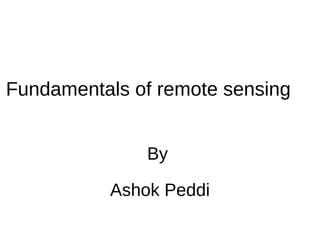
Fundamentals of Remote Sensing Explained
- 1. Fundamentals of remote sensing By Ashok Peddi
- 2. Remote sensing is the science of acquiring information about the Earth's surface without actually being in contact with it. This is done by sensing and recording reflected or emitted energy and processing, analysing, and applying that information. Remote Sensing can be done by two different ways 1)Satellites –satellite Images 2)Aircrafts-Arial Photographs Satellite image Aerial photography
- 3. Examples Aerial photography Satellite image
- 4. To analyze(Visual Interpretation) the satellite imagery we use different combination of bands where it will produce two variety of(composite) images 1)True Color Composite(RGB) 2)False Color Composite other( than RGB) True color False Color
- 5. Quickbird PAN – 61 cm
- 6. IKONO S MSS/ XS – 4 m Bagdad , Iraque
- 7. What is a satellite image? Satellite imagery consists of photographs of Earth or other planets made by means of artificial satellites which also gives an opportunity to process the image and conclude with analysis depending on your requirement.
- 8. Description of a Satellite Image Urban area River Urban area Vegetation 3500 m The different Bands Blue Green Red
- 9. Spatial resolution 23 40 Landsat TM 30 m 10 SPOT XS 10 m 70 NOAA/AVHRR 1100 m 120 IKONOS 4m The value retained in each pixel is designated by digital number and it translates the solar energy reflected by the earth surface (covered by the pixel).
- 11. Urban area River Urban area 3500 m Blue Green Red
- 12. Blue Gree Red Spectral Resolution TM 1 nTM 2 TM 3 Near Infrared Middle Infrared Middle Infrared TM 4 TM 5 TM 7 432 743
- 13. Components of a remote sensing system A – Energy source of illumination F – Transmissions, reception and processing B – Interaction with the atmosphere G – Interpretation and analysis C – Interaction with the target E – Recording of energy by the sensor
- 14. v = frequency (number of cycles per second passing a fixed point) Wavelength is measured in meters (m) or some factor of meters such as nanometres (nm, 10-9 m), micrometers (μm, 10-6 m) or centimeters (cm, 10-2 m). Frequency is normally measured in hertz (Hz), equivalent to one cycle per second, and various multiples of hertz.
- 15. Quantity of radiant energy is expressed in energy units. Quality of radiant energy is characterised by frequency (u) or wavelength (l). c=lu c - velocity of light (3x108m/s) Wavelength and frequency are inversely related to each other: • the shorter the wavelength, the higher the frequency; • the longer the wavelength, the lower the frequency.
- 17. Electromagnetic spectrum The electromagnetic spectrum is the range of all possible frequencies of electromagnetic radiation.* The "electromagnetic spectrum" of an object has a different meaning, and is instead the characteristic distribution of electromagnetic radiation emitted or absorbed by that particular object. *The energy in remote sensing is in the form of electromagnetic radiation.Electro magnetic Radiation is a particular form of energy emitted and absorbed by charged particles
- 19. The visible portion of the spectrum is a very small part of the whole spectrum: •blue - 0.4 a 0.5 mm •green - 0.5 a 0.6 mm •red - 0.6 a 0.7 mm. 1 mm = 10-6 m The wavelengths smaller than 0.4 mm entails: • gamma rays • x rays • ultraviolet radiation
- 20. The part of the electromagnetic spectrum with wavelengths larger than 0.7 mm entails: • infrared (0.7-10 mm), • microwaves (1mm-1m) • radio waves. Infrared goes from 0.7 mm to 10 mm and can be divided in three areas: • Near infrared (0.7-1.0 mm), • medium infrared (1.3-3.0 mm) • thermal infrared (> 3 mm).
- 21. Interaction of electromagnetic radiation with atmosphere The atmosphere has a strong effect on the quantity and quality of the electromagnetic radiation captured by the satellite. The atmosphere effect varies with: • radiation path (airplane, satellite) • wavelength • atmospheric conditions (particles, gases, …) • ...
- 22. Before radiation used for remote sensing reaches the Earth's surface it has to travel through some distance of the Earth's atmosphere. Particles and gases in the atmosphere can affect the incoming light and radiation. These effects are caused by the mechanisms of: • scattering • absorption. What is the effect of atmosphere in the satellite images? • Atmosphere reduces contrast • Atmosphere may blur the images • Atmospheres may reduce the quantity of radiation
- 23. I hope that was useful @ashokped Thank you!
